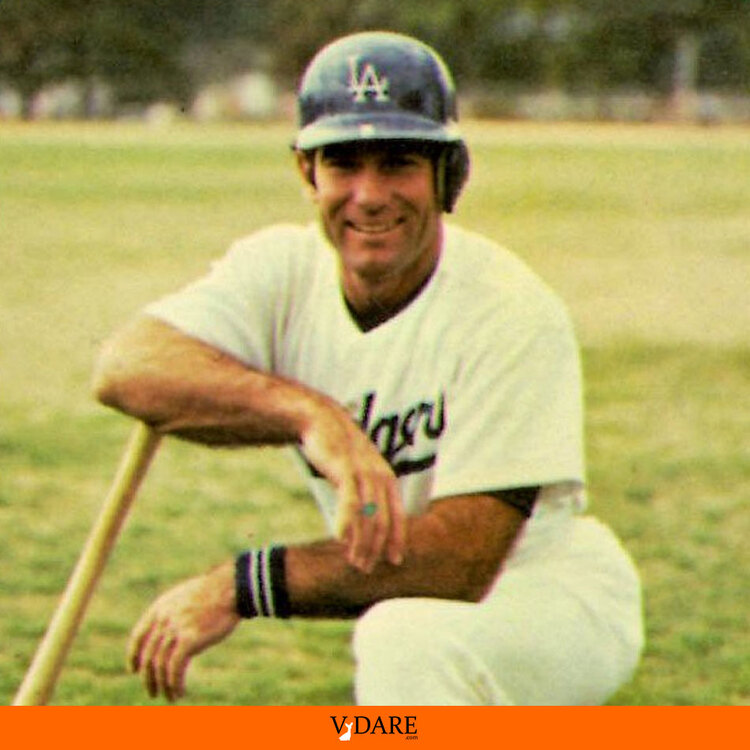
By Steve Sailer
03/06/2024
How good a baseball player was first baseman Steve Garvey, who will face Democratic Rep. Adam Schiff in the runoff for a California seat in the U.S. Senate? I’ve been thinking about Garvey’s baseball career for 53 years, so I’m happy for an excuse to consider it once more.
While I’ve noticed famous basketball players like Wilt Chamberlain, Dennis Rodman, Bill Walton, Patrick Ewing, Mark Eaton, and Horace Grant in daily life due to their extraordinary height, Garvey is one of only two baseball players I’ve run into (Mike Scioscia at a golf course in roughly 2019), and I saw him twice — once at a performance of the musical Annie with his wife and kids in 1976 (?), looking like a civic monument, and once much more relaxed at a Los Angeles Chinatown restaurant with what looked like business cronies after a Dodger game in 1982.
This is because Garvey was extremely handsome. Los Angeles is not lacking in good-looking people, but the Florida-raised Garvey stood out.
Garvey was one of the most celebrated baseball players of the 1970s, but more modern baseball analysts have harped on his flaws. He didn’t walk much, so his on-base percentage wasn’t as good as his battng average (he batted .301 from age 20-33 in 1969-1982 with the L.A. Dodgers, but his OBP was only .337 with the Dodgers). And he got slow after his 1974 Most Valuable Player season, leading the National League twice in grounding into double plays.
Plus Garvey always had a terrible throwing arm. I can recall going to a game at Dodger Stadium in 1971 in which he played third base, driving in three runs and making two errors. “Interesting,” I thought. “What are they going to do with this kid?”
In 1973, the Dodgers gave up on the idea of making Garvey a third baseman or an outfielder and finally put him at his natural position of first base. From 1974-1981, the Dodgers started the season with the same four infielders: Steve Garvey, Davey Lopes, Bill Russell, and Ron Cey. Last I checked that’s twice as long as any other team in baseball history had the same four infield starters. None are in the Hall of Fame, but still… having four fine infielders for eight straight seasons is an immense luxury.
Despite his flaws, Garvey was an exciting player who hit a large number of hard line drives, with at least 200 hits and 300 totals bases in six of seven seasons from 1974-1980. He was an outstanding postseason player, batting .338 in playoff games. He played in four World Series for the Dodgers and one for the San Diego Padres, in large part due to his tremendous play in the league championship series, with 21 RBI in 22 games.
Less important, he was a great All Star Game player.
Garvey’s Dodgers went to four World Series (finally winning one in 1981), which is even more impressive than it sounds because L.A. was in the same division as the Cincinnati Reds. The Big Red Machine of 1975-76, with Pete Rose, Johnny Bench, Joe Morgan, and Tony Perez, is one of the most deservedly famous baseball teams ever. Yet the Dodgers, not the Reds, won the West Division and went to the World Series in 1974, 1977, and 1978.
How important was Garvey to the success of the Dodger infield? Modern analytics point to Cey and Lopes being a little better than Garvey, with Russell not far behind, which I can well believe.
Yet, still, I suspect that Garvey was critical to the other three infielders being able to last as long as they could. Bill James describes them as primarily good offensive players. Garvey couldn’t throw, but he was an absolute vacuum cleaner at grabbing poor throws out of the dirt. Dodger infielders were instructed to aim low and let Garvey (who was 5’10” and couldn’t jump much) worry about fielding the ball if you bounced it.
My theory is that errors are more destructive of a team than you’d imagine because they lead to dugout acrimony. And the Dodgers of that era had sizable egos, even if Walter O’Malley’s corporate PR machine usually covered up their clashes, while Donald Trump’s mentor George Steinbrenner, owner of the New York Yankees, whom the Dodgers played in the World Series of 1977, 1978, and 1981, emphasized clashes between himself, slugger Reggie Jackson, catcher Thurman Munson, and manager Billy Martin to sell tabloids.
My recollection from watching Dodger games is that Garvey prevented a large number of throwing errors by his teammates.
Garvey, a right-hander who couldn’t throw, won the National League first base Gold Glove award four seasons in a row from 1974-1977. But then left-hander Keith Hernandez, who would have been a great third baseman if lefties could play third base, won the next 11 first base Gold Gloves. So, not unreasonably, nobody remembers that Garvey was a pretty good defensive first baseman for his era because Hernandez was so much better.
Of course, none of this is very relevant to who should be the next California Senator. But, still, I’ve been thinking about Garvey for 50 years, so I’m happy to have an excuse at this late date to talk about him.
This is a content archive of VDARE.com, which Letitia James forced off of the Internet using lawfare.